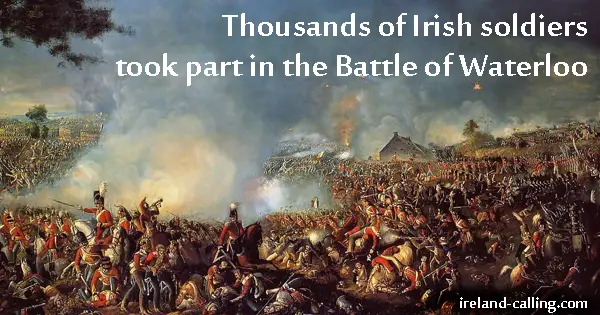When people think of Ireland’s military history, they often think of rebellions against the British and men such as Theobald Wolfe Tone and Michael Collins.
There are countless more Irish men who fought for independence, and many of them are now celebrated as national heroes.
However, there are several wars and battles that claimed the lives of thousands of Irish men that are somewhat overlooked. These forgotten Irishmen were fighting as part of the British Army.

The Battle of Waterloo is one of these battles. The defeat of Napoleon is considered a British victory, and is celebrated as an event of great national pride by Britons.
What many forget, is that Ireland was a part of Britain right up until the early part of the 20th century.
Up until that point, the British Army was always packed with Irish soldiers. The country was a rich recruitment ground with a surplus of young men in need of work. Unlike in Britain, where there was an industrial revolution taking place, young men in Ireland had few prospects of earning a living.
For that reason, there were always as many Irish people willing to go to war for Britain, as to go to war against them.
A considerable amount of the Duke of Wellington’s army was Irish in the Battle of Waterloo, 40% in fact according to historian Kevin Myers.
Wellington was himself an Irishman, born in Dublin in 1769. His army contained thousands of Irish men and it wasn’t just foot soldiers either; many of Wellington’s commanding officers were born in Ireland.
The Act of Union of 1801 merged the Irish Artillery with the Royal Artillery. It is estimated that the Royal Welsh Fusiliers was made up of roughly 150 Welsh soldiers and 840 Irish.
The regimental song of the 32nd (Cornish) Foot contained the phrase ‘Erin Go Bragh’, meaning Ireland forever. The British Army also contained several Irish surgeons and medics, brought along to tend to the wounded.
The Battle of Waterloo was split into two main conflicts. Before the main battle there was a holding action at the crossroads of Quatre Bras on 16th June 1815.
There were several fatalities at this point, many being suffered by Irish soldiers. One Irish soldier named James Burke, a veteran of the Peninsular War, was fatally wounded, as were a group of young Irish recruits who were badly positioned and left helplessly exposed to an attack by Napoleon’s men.
One Irish soldier named Christopher Clarke took out three enemy soldiers before being slashed and killed himself by 22 sabre cuts.
Two days later the main Battle took place. Both sides had already lost significant numbers of men in the conflicts of the previous days. One of the main sites of the battle was at Hougoumont Farm, which the British used as a fortress.
Many reckless decisions were made by the commanding officers of both sides. Hundreds of French soldiers were sent forward towards the British fortress to be mercilessly killed.
Major-General Sir William Ponsonby, a member of the Irish Parliament, was commanding officer of the Union Brigade. He foolishly led his men on a charge into enemy lines, only to get trapped by the sticky mud. He immediately recognised his error and handed his personal effects over to his deputy and waited for his inevitable fate.
There were Irish soldiers in almost all of the British regiments that took part in the Battle of Waterloo. Wellington described Co Monaghan soldier James Graham as the bravest man on the battlefield after he saved the life of one of his comrades who was about to be shot by a French sniper, and also rescued his brother who lay wounded in a burning building.
More history articles
The Neolithics – first people to leave their mark on Ireland
